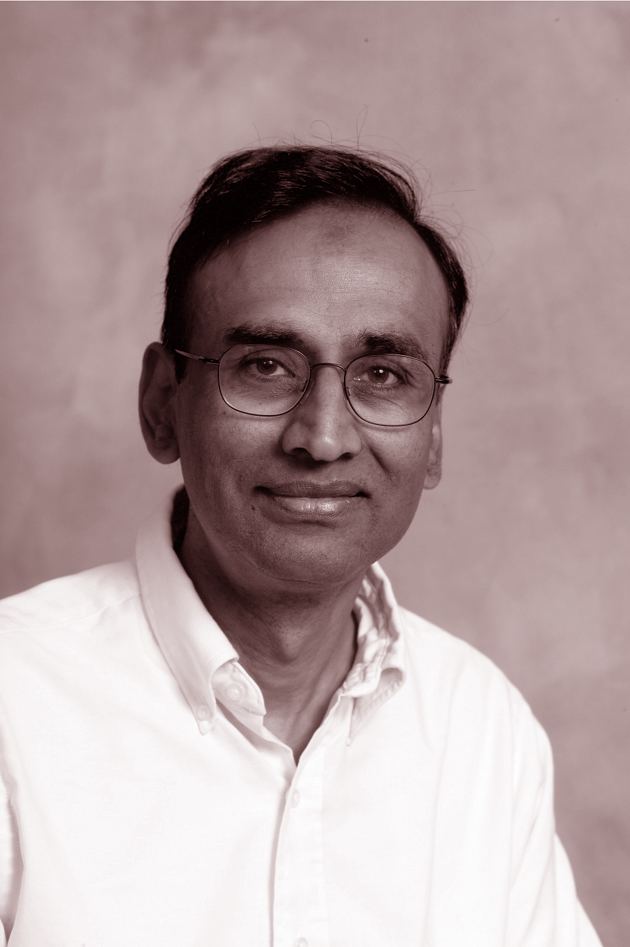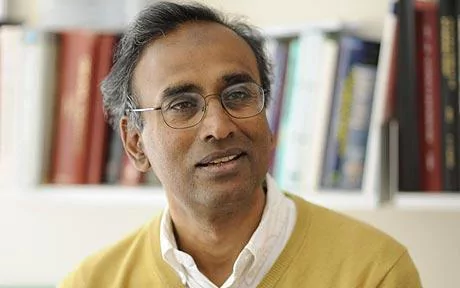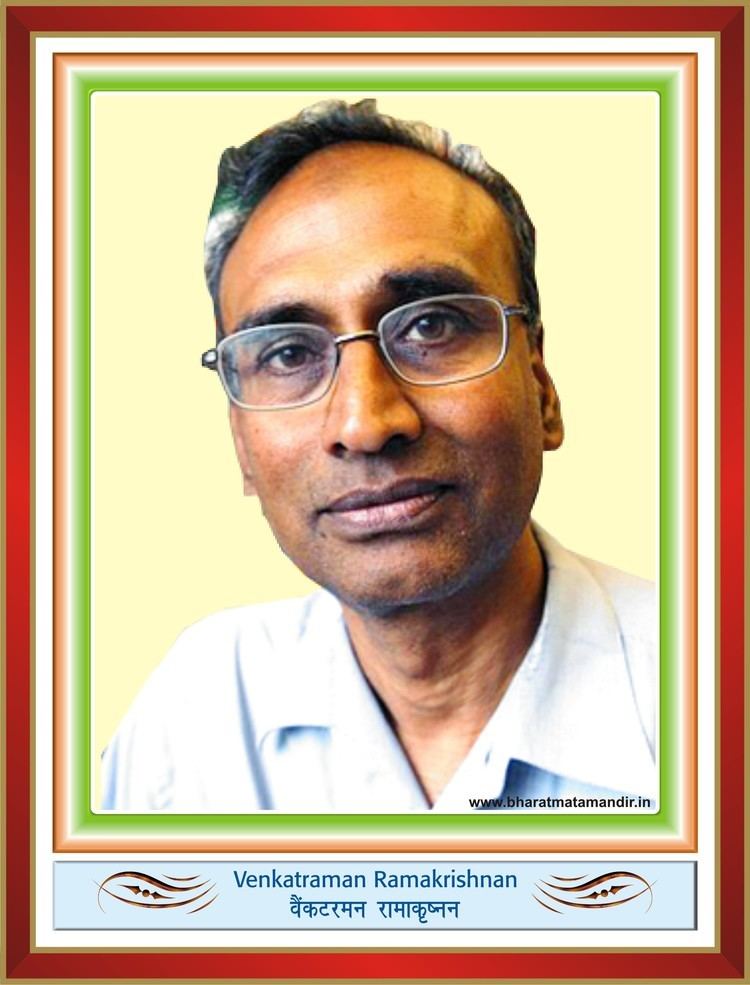Residence United Kingdom Fields Biochemistry, Biophysics Nationality American, British | Role Structural biologist Name Venkatraman Ramakrishnan | |
 | ||
Native name வெங்கட்ராமன் ராமகிருஷ்ணன் Citizenship United States
United Kingdom
India (should be removed under The Constitution of India) Institutions Laboratory of Molecular Biology
University of Cambridge
Oak Ridge National Laboratory
Yale University
University of Utah
Brookhaven National Laboratory Alma mater Maharaja Sayajirao University of Baroda (BSc)
University of California, San Diego
Ohio University (PhD) Thesis The Green Function Theory of the Ferroelectric Phase Transition in Potassium Dihydrogen-Phosphate (1976) Awards Nobel Prize in Chemistry, Padma Vibhushan, Guggenheim Fellowship for Natural Sciences, US & Canada Education Ohio University (1976), Maharaja Sayajirao University of Baroda, University of California, San Diego Similar People Thomas A Steitz, Ada Yonath, Har Gobind Khorana, Subrahmanyan Chandrasekhar, William Lipscomb | ||
Venkatraman ramakrishnan to the top of british royal society
Venkatraman "Venki" Ramakrishnan (born 1952) is an American and British structural biologist of Indian origin. He is the current President of the Royal Society, having held the position since November 2015. In 2009 he shared the Nobel Prize in Chemistry with Thomas A. Steitz and Ada Yonath, "for studies of the structure and function of the ribosome".
Contents
- Venkatraman ramakrishnan to the top of british royal society
- Venkatraman ramakrishnan mp4
- Education and early life
- Career and research
- Awards and honours
- Personal life
- References

Since 1999, he has worked as a group leader at the Medical Research Council (MRC) Laboratory of Molecular Biology (LMB) on the Cambridge Biomedical Campus, UK, where he is also the Deputy Director.

Venkatraman ramakrishnan mp4
Education and early life

Ramakrishnan was born in Chidambaram in Cuddalore district of Tamil Nadu, India to C. V. Ramakrishnan and Rajalakshmi Ramakrishnan in a Tamil family. Both his parents were scientists, and his father was head of department of biochemistry at the Maharaja Sayajirao University of Baroda. At the time of his birth, Ramakrishnan's father was away from India doing postdoctoral research with David E. Green at the University of Wisconsin–Madison in the US.

His mother obtained a PhD in Psychology from McGill University in 1959 which she completed in only 18 months, and was mentored by Donald O. Hebb. Lalita Ramakrishnan, his younger sister, is professor of immunology and infectious diseases at the Department of Medicine, University of Cambridge, and is a member of the National Academy of Sciences.
Ramakrishnan moved to Vadodara (previously also known as Baroda) in Gujarat at the age of three, where he had his schooling at Convent of Jesus and Mary, except for spending 1960–61 in Adelaide, Australia. Following his pre-science at the Maharaja Sayajirao University of Baroda, he did his undergraduate studies in the same university on a National Science Talent Scholarship, graduating with a Bachelor of Science degree in Physics in 1971. At the time, the physics course at Baroda was new, and based in part on The Berkeley Physics Course and The Feynman Lectures on Physics.
Immediately after graduation he moved to the U.S., where he obtained his PhD degree in Physics from Ohio University in 1976 for research into the ferroelectric phase transition of potassium dihydrogen phosphate (KDP) supervised by Tomoyasu Tanaka. He then spent two years studying biology as a graduate student at the University of California, San Diego while making a transition from theoretical physics to biology.
Career and research
Ramakrishnan began work on ribosomes as a postdoctoral fellow with Peter Moore at Yale University. After his post-doctoral fellowship, he initially could not find a faculty position even though he had applied to about 50 universities in the U.S.
He continued to work on ribosomes from 1983-95 as a staff scientist at Brookhaven National Laboratory. In 1995 he moved to the University of Utah as a Professor of Biochemistry, and in 1999, he moved to his current position at the Medical Research Council Laboratory of Molecular Biology in Cambridge, England, where he had also been a sabbatical visitor during 1991-92.
In 1999, Ramakrishnan's laboratory published a 5.5 Angstrom resolution structure of the 30S subunit. The following year, his laboratory determined the complete molecular structure of the 30S subunit of the ribosome and its complexes with several antibiotics. This was followed by studies that provided structural insights into the mechanism that ensures the fidelity of protein biosynthesis. More recently in 2007 his laboratory has determined the atomic structure of the whole ribosome in complex with its tRNA and mRNA ligands. Ramakrishnan is also known for his past work on histone and chromatin structure.
As of 2015 his most cited papers (according to Scopus) have been published in Nature, Science, and Cell.
Awards and honours
Ramakrishnan was elected a Member of the European Molecular Biology Organization (EMBO) in 2002 and a Fellow of the Royal Society (FRS) in 2003. He was elected a Member of the U.S. National Academy of Sciences in 2004. In 2007, Ramakrishnan was awarded the Louis-Jeantet Prize for Medicine and the Datta Lectureship and Medal of the Federation of European Biochemical Societies (FEBS). In 2008, he won the Heatley Medal of the British Biochemical Society. Since 2008, he is a Fellow of Trinity College, Cambridge and a foreign Fellow of the Indian National Science Academy.
In 2009, Ramakrishnan was awarded the Nobel Prize in Chemistry along with Thomas A. Steitz and Ada Yonath. He received India's second highest civilian honor, the Padma Vibhushan, in 2010. Ramakrishnan was knighted in the 2012 New Year Honours for services to Molecular Biology, but does not generally use the title 'Sir'. In the same year, he was awarded the Sir Hans Krebs Medal by the FEBS. In 2014, he was awarded the XLVI Jiménez-Díaz Prize by the Fundación Conchita Rábago (Spain). Ramakrishnan was included as one of 25 Greatest Global Living Indians by NDTV Channel, India on 14 December 2013. His certificate of election to the Royal Society reads:
Personal life
Ramakrishnan married Vera Rosenberry, an author and illustrator of children's books, in 1975. His stepdaughter Tanya Kapka is a doctor in Oregon, and his son Raman Ramakrishnan is a cellist based in New York.
